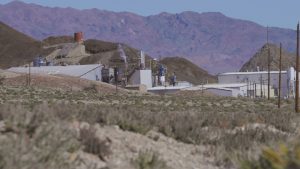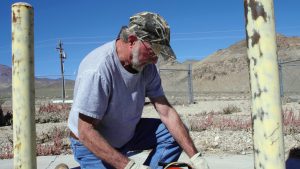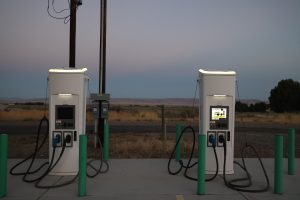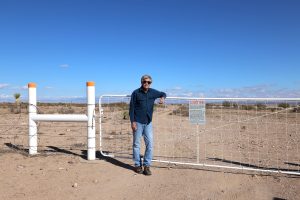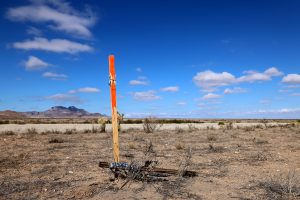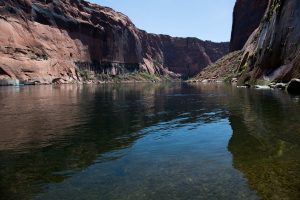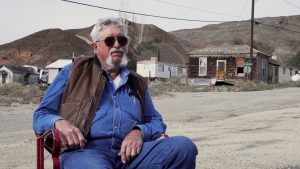The coming electric battery revolution in America will require billions upon billions of gallons of water to mine lithium – and many of the new U.S. mines will be located in the drought-prone American West. An investigative report from the Howard Center at Arizona State University. Find more stories from the project here and here.
- Slug: Howard Center-Lithium Liabilities (Short Version). 1,772 words. By Reporters from the Howard Center for Investigative Journalism.
- Extended version of 5,782 words also available.
- Photos available (thumbnails, captions below).
SILVER PEAK, N.V. — Nyle Pennington, a veteran water scientist who tracks groundwater for local governments, stopped at a monitoring station just one mile from America’s only active commercial lithium mine. For years this well in Central Nevada typically held enough fresh water to reach the height of a three-story building, or about 30 feet. Pennington said it supplied much-needed nourishment for local cattle grazing under the Nevada sun.
On this crisp fall day in October, Pennington dropped a small rock down the well. Pings and clangs rang out as the rock hit bottom. A soft thud echoed back. “Bone dry,” he said. “If that would have had water in it, you would have heard a pronounced loud splash.”
Pennington, hired by the Central Nevada Regional Water Authority to monitor groundwater levels, has documented a disturbing pattern: underground water sources are dwindling and even disappearing altogether near the Silver Peak lithium mine, which records show has pumped nearly four billion gallons of water or more from underground every year since 2020. The Silver Peak mine operator said it is not impacting freshwater aquifers, but Pennington said he recorded evidence that shows otherwise.
Silver Peak, which began mining lithium in the 1960s, won’t remain the only U.S. lithium mine for long. The Howard Center for Investigative Journalism at Arizona State University has documented a surge of proposals to open lithium mines that will, like Silver Peak, need billions of gallons of water to operate at a time when much of America’s West is emerging from a megadrought.
As part of a Biden administration push to “build America’s electric vehicle future,” U.S. officials are encouraging the domestic expansion of lithium mines by dangling federal incentives. The effort would decrease U.S. reliance on China, which controls most of the U.S. supply chain for lithium, a crucial mineral also needed to power computers and military equipment.
It’s a case of hidden hazards, where helping the environment in one way may hurt it in another.
Howard Center reporters undertook a national investigation of the likely impact of 72 proposed lithium mines in nine states, reviewing tens of thousands of pages of state and federal environmental impact statements and mining operation reports. The documents were filed with federal, state and county regulators by U.S. and foreign companies that sought permits or reached the physical exploration phase for new U.S. lithium mines by the end of December 2023.
Among the investigation’s key findings:
- There are no federal rules governing how much water any type of mine can consume.
- America’s only operating commercial lithium mine is responsible for drying up nearby groundwater monitoring wells, according to reports from a government entity that monitors water levels for nine Nevada counties.
- The vast majority of proposed lithium projects responding to official calls for increased supplies of domestic lithium are owned by foreign companies or their subsidiaries.
- The majority of proposed lithium projects in the U.S. intend to take water from already stressed sources like the Colorado River or strained groundwater systems.
- Federal authority to stop mines from extracting minerals, even from public land, is weak. The Department of the Interior, in more than 20 years, has not rejected a mining permit due to the harm a mine could cause.
If all of the 72 proposed lithium mines whose documents the Howard Center examined are built “it would be a fundamental transformation of the American West,” said Patrick Donnelly, a conservation biologist for the nonprofit Center for Biological Diversity, an environmental advocacy group. “People compare it to the Gold Rush, but the Gold Rush was pretty small scale, compared to what all this lithium’s looking like.”
Nevada, America’s driest state, is home to 40 of the 72 proposed lithium mines whose paperwork the Howard Center examined. The majority in Nevada – 80 percent – would be built on top of water supplies already tagged by the Nevada Division of Water Resources for special monitoring because of possible risk to water levels, according to the Howard Center’s analysis.
The 72 proposed lithium mines examined are not only in the West. In North Carolina, residents worried that a proposed lithium mine might cause residential wells to run dry. In Arkansas, as in Nevada, operators of proposed mines want to pull mineral-heavy water from the drier parts of the state.
Warning signs from Silver Peak?
At the Silver Peak lithium mine, annual reports from the Central Nevada Regional Water Authority have repeatedly warned of problems. The 2022-23 authority’s report found that decreases in local water levels near Silver Peak were “due exclusively to de-watering throughout Clayton Valley for Lithium Mining purposes.”
Getting the lithium mine to directly address the water authority’s findings proved difficult, as direct questions about the mine’s impact on water levels were met with confusing and conflicting answers.
The Howard Center said via email, in requesting an interview with the mine’s owner Albemarle, that reporters intended to ask about how “local scientists at the Central Nevada Regional Water Authority have identified groundwater monitoring wells near the Silver Peak mine as having reduced amounts of water (or running dry)” and said in reports the Silver Peak mine is responsible.
Silver Peak’s site operations manager, Scott Thibodeaux, was provided to speak to the reporters and said he was unable to answer key questions.
“I’m not familiar with the particulars,” Thibodeaux said. “Perhaps someone within the organization is. I am not myself.” Thibodeaux said he is responsible for overseeing mining and the processing of lithium at the Silver Peak lithium mine. That means he oversees key parts of the operation that consume large amounts of water.
One day after the Zoom interview, Albemarle spokesperson Allison Eckley issued a statement that said in part and in bold: “Albemarle operations do not impact the freshwater aquifers in the area.”
Yet a February 2023 Albemarle environmental disclosure filed with the Securities and Exchange Commission noted “Requirements” to use what the report labels as “Fresh Water,” in an amount equivalent to 190 million to 222 million gallons per year.
Asked about that in a followup email, Eckley acknowledged fresh water is used by the operation and said usage is “not expected to increase significantly” by 2025, when Albemarle plans to increase pumping of salty, lithium-rich water to a new level equivalent to 6.5 billion gallons a year.
Eckley said the company is permitted by the state for its water use and in an email wrote, “It is the responsibility of the State Engineer to administer the groundwater resources in the basin to avoid permanent effects.”
Albemarle’s SEC disclosure shows that if the company increases pumping to 6.5 billion gallons a year, the water basin will be “pumped at or over” the amount that naturally recharges every year.
“I think the alarm bells have been rung,” said Jeff Fontaine, executive director of the Central Nevada Regional Water Authority. “I think there are a lot of people concerned about what’s happening in Clayton Valley, but I don’t know that there’s agreement on what needs to be done.”
Mining water
Documents from the majority of proposed lithium projects in the U.S. show that they intend to take water from already stressed sources, according to a Howard Center analysis. Two projects near Southern California’s Salton Sea, an area California Gov. Gavin Newsom (D) dubbed “the Saudi Arabia of lithium,” told regulators they plan to use billions of gallons of water each year from one of the most stressed waterways in America: the Colorado River.
Forty million people in seven states and Mexico rely on the Colorado River for some, if not all, of their water. The river endured a 21-year “megadrought” from 2000 to 2021 that forced the federal Bureau of Reclamation, which oversees the river, to declare a water shortage for the first time.
Controlled Thermal Resources, a company that began in Australia but moved its headquarters to California in 2022, plans to consume 2.1 billion gallons of fresh water each year from the river. That is enough to provide water from the strained Colorado River for 22,500 households downstream in Arizona. The company disclosed it will need nearly 100 billion gallons of water over the project’s life, which could be as long as 46 years.
“When you put it in terms of gallons, it does sound like a lot of water – and it is a lot of water,” Controlled Thermal Resources President Jim Turner told The Howard Center.
In California, agriculture annually takes more water out of the river than the proposed lithium projects will take. Turner said his company is looking into how it might recycle used water from farms and ranches in the area, while cleaning out any residual chemicals.
No federal rules for mines and water
No federal laws exist governing how much water a mine can consume, the Howard Center found . The main federal law governing mines, and how they operate, was enacted in 1872, a few years after the Civil War. The Government Accountability Office has released at least six reports over the last several decades highlighting problems. The Biden administration has called for modernization of the law and Arizona Congressman Raúl Grijalva (D) is spearheading a bill that would overhaul it. With only Democrats backing his bill, its outcome is uncertain.
Grijalva said the Howard Center’s investigation, shining a spotlight on public disclosures from lithium mines that plan to draw on billions of gallons of water from strained sources, could help attract more bipartisan support for reforms, in light of recent history-making droughts.
“This kind of reporting and study and investigation is critical to the discussion by introducing and prioritizing the issue of water as a consequence going forward,” Grijalva said.
In Nevada, a Howard Center analysis found 28 other planned lithium mines located within 50 miles of Silver Peak.
According to De Winsor, the Esmeralda County commissioner, the county has a budget of only $30,000 for 2023 to defend its water against companies vying to open new lithium mines, as well the Silver Peak’s plan to expand. Albemarle’s revenues increased from $3.3 billion in 2020 to nearly $10 billion in 2022.
“The community needs the water,” said Winsor. “They don’t need to take away from our area to be able to produce green energy. We should be able to survive.”
Reporters in alphabetical order are Alex Appel, Morgan Casey, Francesca D’Annunzio, Tori Gantz, Jordan Gerard, John Leos, Anna Montoya-Gaxiola, Emma Peterson, Joshua Shimkus, Noel Lyn Smith, Pacey Smith-Garcia, Daisy Tanner, Caitlin Thompson, Annika Tourlas and Shelby Rae Wills.
This story was produced by the Howard Center for Investigative Journalism at Arizona State University’s Walter Cronkite School of Journalism and Mass Communication, an initiative of the Scripps Howard Fund in honor of the late news industry executive and pioneer Roy W. Howard. For more see https://azpbs.org/lithium. Contact us at howardcenter@asu.edu or on X @HowardCenterASU.
